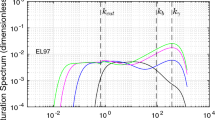Abstract
THE formation of a microwave duct over the sea has been examined in terms of a distribution of potential refractive index (refractive index independent of height in an adiabatic atmosphere) corresponding to a functional relationship originally suggested by Deacon1 to describe the distribution of certain meteorological properties in the boundary layer. Deacon's relationship takes the stability of the atmosphere into account in terms of a profile index, β, which is a function of air−sea temperature difference and wind velocity.
Similar content being viewed by others
References
Deacon, E. L., Quart. J. Roy. Meteor. Soc., 75, 89 (1949).
Schelkunoff, S. A., Bell Telephone Lab. Rept., MM–44–110–53 (July 1944).
Jones, R. F., Nature, 163, 639 (1949).
McPetrie, J. S., and Starnecki, B., Nature, 162, 818 (1948).
Author information
Authors and Affiliations
Rights and permissions
About this article
Cite this article
ANDERSON, L., GOSSARD, E. Oceanic Duct and its Effect on Microwave Propagation. Nature 172, 298–300 (1953). https://doi.org/10.1038/172298b0
Issue Date:
DOI: https://doi.org/10.1038/172298b0
- Springer Nature Limited





